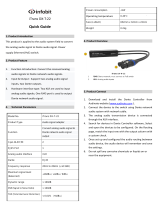
Model 342 User Guide Issue 1, November 2022
Studio Technologies, Inc. Page 15
Model 342
INTERCOM STATION
are sent to the headphone outputs. This prevents us-
ers with extended high-frequency sensitivity, such as
hosts and guests associated with dog shows, from
receiving undesirable audio content.By using a 20 kHz
tone for call signaling the Model 342 is compatible with
legacy intercom equipment, including the venerable
RTS BP-325 beltpack. When interconnecting Mod-
el 342 and BP-325 units using an appropriate Date-
enabled interface, such as the Studio Technologies’ Model
545DR Intercom Interface, call signaling is fully compatible.
Compatibility with the Clear-Com® method of call function-
ality is also possible by using the Model 545DC Intercom
Interface. (It converts the DC call signal associated with
pin 3 of a Clear-Com party-line circuit to a 20 kHz tone.)
Also, devices such as the Studio Technologies’ Model 544D
Audio Interface, Model 5304 Intercom Station, and Model
348 Intercom Station will send and receive 20 kHz signals
that are compatible with the Model 342. The Model 544D
converts its GPI (general-purpose input) signals to 20 kHz
tones and sums them with the audio signals which are then
transported “in band” via the Dante audio paths.
How to Identify a Specic Model 342
Both the Dante Controller and STcontroller software appli-
cations oer a command that can be used to help locate a
specic Model 342. When the Identify command is select-
ed it will send a message to a single Model 342 unit. On
that specic unit the LEDs in the two pushbutton switches
will rapidly ash orange. In addition, the SYS and SYNC
status LEDs, located directly below the etherCON RJ45
receptacle on the back panel, will slowly ash green. After
a few seconds, the LED identication pattern will cease
and normal Model 342 button LED and Dante status LED
operation will resume.
Mic Kill Support
The Model 342 includes a mic kill function, allowing either
or both talk pushbutton switches, if placed in their enabled
(on) state, to be remotely forced to their disabled (off)
state. This function is sometimes referred to as a “talk o”
function. Two actions can enable the mic kill function. Any
time a Model 342 receives a Dante Identify command it
can cause both an LED pattern to start as well as enabling
the mic kill function. The second “trigger” method uses the
Studio Technologies’ Global Mic Kill command. This
command can be activated from a menu choice in the
STcontroller software application.
The reason for the Model 342 to oer a mic kill function
is simple. It’s common in intercom applications for users
to enable (“latch on”) a talk channel and then go “o head-
set,” forgetting that they’ve left one or more talk channel
enabled. While they take a break or go to lunch, all other
users are forced to listen to that channel which may include
unwanted audio. This makes having the ability to disable
talk channels very useful. The Dante Identify command
allows a “latched on” talk channel on a specic Model 342
to be remotely disabled. Alternately, by using the Global
Mic Kill command a large group of units can simultaneously
have their talk channels disabled. This would include any
Studio Technologies’ compatible device that follows this
protocol.
Technical Notes
IP Address Assignment
By default, the Model 342’s Ethernet interface will attempt
to automatically obtain an IP address and associated
settings using DHCP (Dynamic Host Conguration Proto-
col). If a DHCP server is not detected an IP address will
automatically be assigned using the link-local protocol.
This protocol is known in the Microsoft® world as Auto-
matic Private IP Addressing (APIPA). It is also sometimes
referred to as auto-IP (PIPPA). Link-local will randomly
assign a unique IP address in the IPv4 range of 169.254.0.1
to 169.254.255.254. In this way, multiple Dante-enabled
devices can be connected together and automatically
function, whether or not a DHCP server is active on the
LAN. Even two Dante-enabled devices that are directly
interconnected using an RJ45 patch cord should, in most
cases, correctly acquire IP addresses and be able to com-
municate with each other.
An exception does arise when trying to directly interconnect
two Dante-enabled devices that use Ultimo integrated cir-
cuits to implement Dante. The Model 342 uses the UltimoX2
“chip” and, as such, a direct one-to-one interconnection
with another Ultimo-based product is not supported. An
Ethernet switch that links Ultimo-based units is required to
successfully interconnect them. The technical reason that
a switch is required relates to the need for a slight latency
(delay) in the data ow and utilizing an Ethernet switch in
the application deployment will provide this.
Using the Dante Controller software application, the Model
342’s IP address and related network parameters can be
set for a xed (static) conguration. While this is a more-
involved process than simply letting DHCP or link-local
“do their thing,” if xed addressing is necessary then this
capability is available. In this case, it’s highly recommended
that every unit be physically marked, e.g., directly using a
permanent marker or “console tape,” with its specic static
IP address. If knowledge of a Model 342’s IP address has
been misplaced there is no reset button or other method
to easily restore the unit to a default IP setting.
In the unfortunate event that a device’s IP address is “lost,”
the Address Resolution Protocol (ARP) networking com-
mand can be used to “probe” devices on a network for this


























